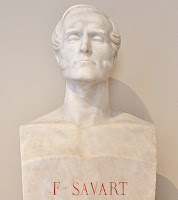 | ||
| Bust of Félix Savart in the Institut de France. From Wikipedia. |
Savart was born in Meziere, France on June 30, 1791. His family had a long history of excelling in engineering, but Savart chose a different path.
Savart decided on a medical career and about 1808 entered the hospital in Metz. From 1810 to 1814 he served as a regimental surgeon in Napoleon’s armies… After discharge from the army, he completed his medical training in Strasbourg, where he received his doctor’s degree in October 1816. The title of his doctorate thesis was "Du cirsocele." The mundane topic of varicocele [enlarged veins in the scrotum] must have had little intrinsic appeal for him, and it is perhaps slight wonder he did not stay in medicine.I can understand how that topic might drive a person away from the medical profession. For whatever reason, Savart spent little time practicing medicine. Instead, he was interested in physics, and particularly in sound.
In 1817 Savart returned to Metz with the intention of establishing a medical practice… He spent his time “more in fitting out a laboratory and building instruments than in seeing sick people and perusing Hippocrates…” It was during this period that he… began to devote himself specifically to the study of acoustics, a subject which engaged his attention almost exclusively for the remainder of his life.McKusick and Wiskind compare Savart to three other physicians who made the transition to physics: Hermann von Helmholtz, Thomas Young, and Jean Leonard Marie Poiseuille. When Savart was 28, he made a life-changing trip to Paris.
In 1819 Savart went to Paris… to consult Jean-Baptiste Biot (1774–1862) in connection with his study of the acoustics of musical instruments. This was undoubtedly a turning point in Savart’s career. Biot encouraged and aided Savart in many ways and took him into collaboration in a study of electricity.Savart’s name appears in Intermediate Physics for Medicine and Biology only when paired with Biot for the Biot-Savart Law. Russ Hobbie and I write
8.2.3 The Biot-Savart Law
In situations where the symmetry of the problem does not allow the [magnetic] field to be calculated from Ampere’s law, it is possible to find the field due to a steady current in a closed circuit using the Biot-Savart law.
Ironically, Savart is remembered among physicists for this one investigation into magnetism rather than a lifetime studying acoustics.
Savart was an excellent experimentalist and instrument builder. He made careful measurements of the frequencies produced by a trapezoid violin, which a French commission found to be as good as the violins of Stradivarius. McKusick and Wiskind describe one of his more significant inventions: the Savart wheel.
About 1830 Savart invented a toothed wheel for determining the number of vibrations in a given musical tone. He attached tongues of pasteboard to the hoop of the wheel and arranged for these to strike a projecting object as the wheel was turned… [With this invention] Savart [determined] the frequency limits of audibility of sounds for the human ear [see Section 13.4 in IPMB]. He set the low and high values at 8 and 24,000 cycles per second, respectively... The values he determined are of the same order of magnitude as the 16 to 16,000 cycles per second one usually hears quoted now.Savart also has a unit named for him.
The savart is a unit related to the perceptible change in frequency; 300 savarts are approximately equal to one octave. However, this unit has not enjoyed general acceptance and usage.Another unit for frequency interval, discussed previously in this blog, is the cent. A savart is about 4 cents.
Savart became of member of the French Academie des Sciences in 1827, a position he held “until his untimely death on 16 March 1841 at the age of fifty years.”
Félix Savart is a biological physicist in the mold of Helmholtz, Young, and Poiseuille. He’s just the sort of interdisciplinary scientist that Russ and I had in mind when writing Intermediate Physics for Medicine and Biology.
Bart Hopkin describes the Savart wheel.
https://www.youtube.com/watch?v=yhen0XGyheY
A Trapezoid violin, designed by Félix Savart.
https://www.youtube.com/watch?v=Q3npNDKkqsc



No comments:
Post a Comment